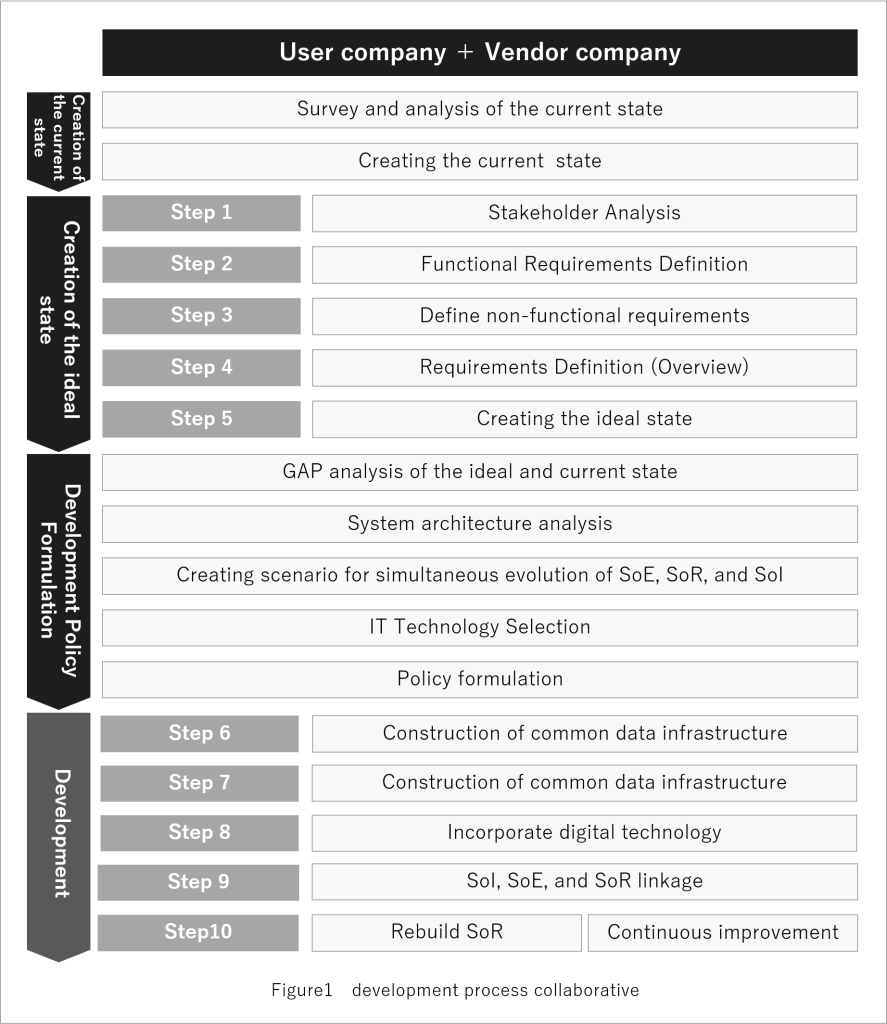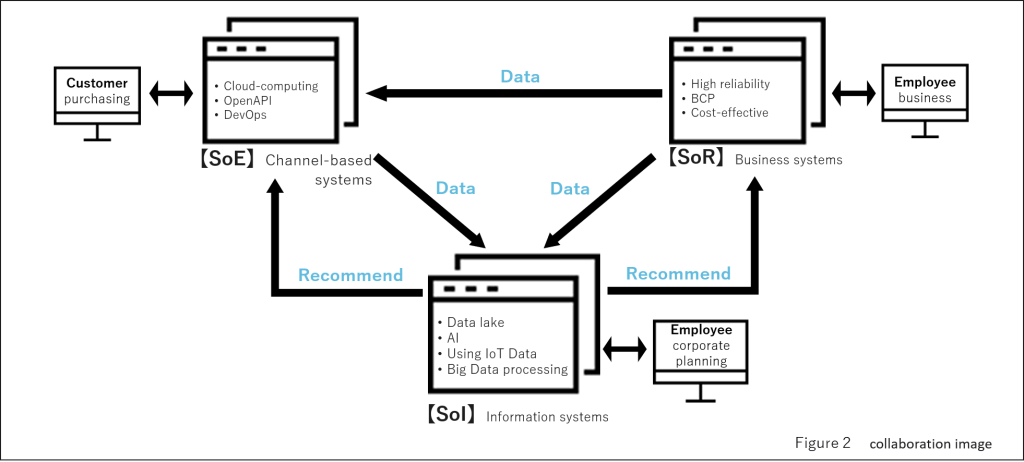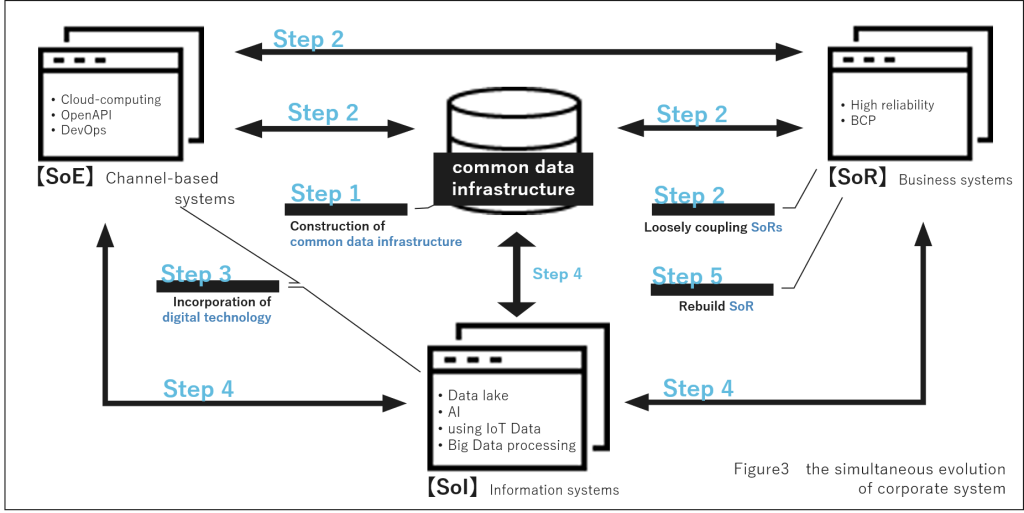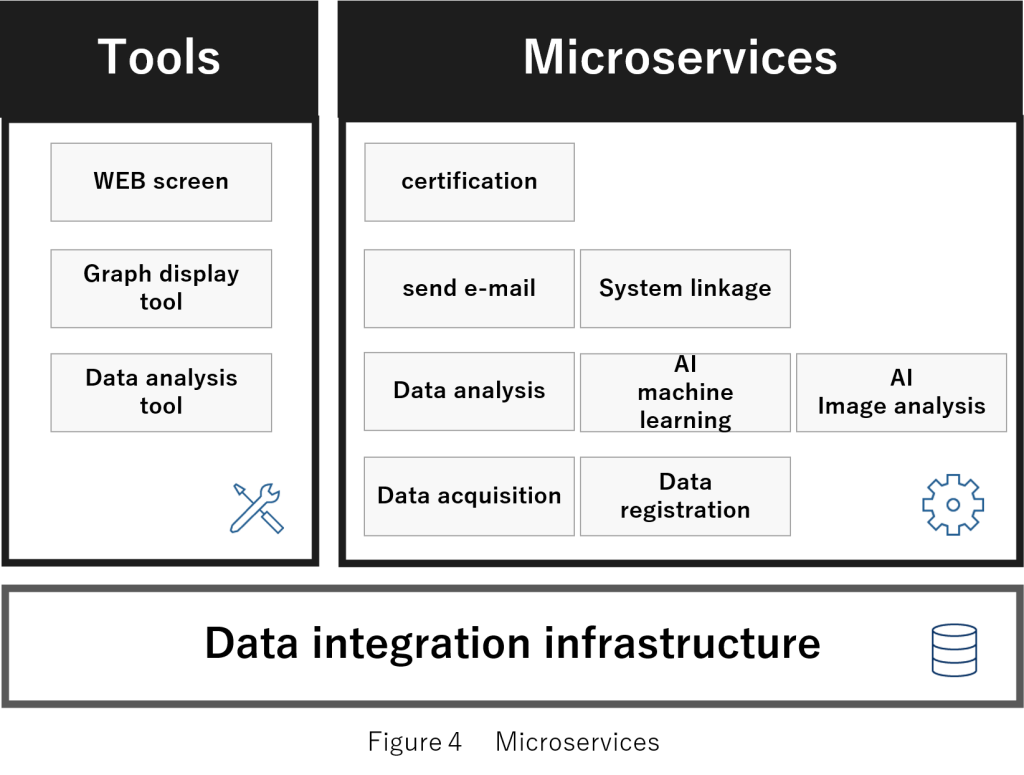Summary
During promoting DX where creation alters the new Business Models for which an enterprise utilized new digital technology flexibly, the problem which must correspond can mention “Modernization of a legacy system” and “Upbringing of Digital human resources”. We will describe these technical solutions, “SoE・SoR・SoI Simultaneous evolution”, “The co-creation type development”. Finally, I will talk about the author’s future challenges for DX success.
1.Introduction
This article is a reprint of an article that appeared in the July 2021 (special issue) of the Journal of gijyutsu-shi
Digital Transformation (DX) is defined by the Ministry of Economy, Trade and Industry’s “DX Promotion Index” (*1) as “the transformation of products, services, and business models based on the needs of customers and society by leveraging data and digital technology in response to rapid changes in the business environment. DX is defined as “the transformation of products, services, and business models based on the needs of customers and society, as well as the transformation of the business itself, organization, processes, and corporate culture and climate to establish a competitive advantage.
This paper describes the author’s experience in DX realization, expectations for DX acceleration due to the spread of 5G information and communication technology, and the future of technology.
2.DX Issues
2.1 current conditions
According to the Ministry of Economy, Trade and Industry’s “DX Report2,” more than 90% of the 500 companies as of October 2020 are either not working on DX at all or are only sporadically implementing it(*2). Also, according to a survey by the Japan Information System Users Association, 90% of companies have legacy systems, and nearly 80% of them are “holding back the promotion of DX” (*3). In addition, 80% of IT budgets of domestic companies are allocated to system maintenance and operation, indicating the difficulty of making new investments(*4). In addition, the Ministry of Economy, Trade and Industry’s “Survey on IT Human Resources Supply and Demand” predicts that there will be a shortage of 360,000 IT personnel in 2025 and 450,000 in 2030 (*5).
2.2 issue
The current state of DX makes modernization of legacy systems and securing and training digital human resources a challenge.
(1) System Modernization
Legacy systems held by companies support business continuity. Many of these systems were originally developed by vendors decades ago on a custom basis and have been modified each time laws are revised, or new services are introduced, resulting in a tightly coupled software structure. In addition, each department has prioritized system optimization, making the system complex and making it difficult to utilize and manage data across the entire company. Modernization of these systems will be necessary in order to respond quickly to changes in the business environment.
(2) Digital Human Resource Development
Modernization of legacy systems will eliminate system complexity and improve maintainability, thereby gradually reducing the IT budget for maintenance and operations. In addition, personnel resources for maintenance and operations can also be reduced. To ensure the success of DX, it is necessary to allocate this budget and personnel resources to the use of digital technology and to develop digital human resources.
3. Technical solutions
DX requires not only the modernization of legacy systems, but also the simultaneous evolution of the entire company’s systems, as customer support becomes a higher priority.
In order to simultaneously evolve, first, the current state and the ideal state are created. Next, a GAP analysis is conducted between the ideal and current state, and scenarios for simultaneous evolution are created by applying SoE, SoR, and SoI (Systems of Engagement, Systems of Record, and Systems of Insight) to individual systems, mainly based on the GAP. The scenario is then formulated as a development policy and development is implemented.
By making this development process collaborative between the user company and vendor company, we can realize the ideal state of the product. It is also expected to have the effect of transferring the vendor’s technical capabilities to the user company, leading to the development of digital human resources.
This section describes the main processes shown in Figure 1, focusing on technological solutions.

3.1 Creation of the ideal state
The systems thinking method is used to decompose and organize individual functions even in complex systems where it is difficult to see the whole picture.
For unclear customer requirements, the OODA Loop is used to clarify the requirements based on situational judgment through observation. The OODA loop is an acronym for Observe, Orient, Decide, Act. First, the situation is ascertained by observing the customer. Next, the situation is assessed, a direction is determined, a decision is made on how to act, and the action is taken. Then, the results of the action are judged, and the next OODA cycle is repeated, allowing the action to be modified in response to changing circumstances.
(1)Using Systems Thinking Methodology
One of the factors complicating the current business environment is the variety of stakeholders. Therefore, the first step is to start with stakeholder analysis, which is addressed in the steps shown below.
Step 1: Stakeholder Analysis
Analyze value among stakeholders. Value refers to the benefits relative to the costs. Benefits are useful, important, and beneficial to stakeholders, and are obtained when the ideal or expected state is approached. For example, value can be a product or service, as well as laws and regulations, information, knowledge, and reputation.
Step 2: Functional Requirements Definition
Define the requirements that must be realized among the values identified in the stakeholder analysis.
Step 3: Define non-functional requirements
Define requirements that should be additional to the functional requirement in achieving the functional requirement. For example, if functional requirement is “to book a ticket,” then additional requirements such as quicker and easier.
Step 4: Requirements Definition (Overview)
Decompose the functional requirement definition into functions and measures. For example, if the functional requirement is “to reserve a ticket with a reservation system,” the function is “to reserve a ticket” and the measure is “reservation system.
Non-functional requirements define specific achievement levels. For example, if the user wants to make a reservation quickly, the reservation time is “within 1 second.
Step 5: Creating the ideal state
The items defined in Step 4 are consolidated by the stakeholder/measure to create an overall picture from the perspective of the stakeholders and the measure. The result is an ideal image that includes not only services for stakeholders, but also laws and regulations. I have handled the above steps through work-style discussions with the people in charge of the project. There was a gap between management and those in charge of business in terms of their thoughts on system restructuring, and those in charge of business were reluctant to change existing operations. Therefore, we tried to improve their awareness of participation by reflecting their opinions in the ideal form. In addition, to encourage as many opinions as possible, we devised the use of ICT tools for brainstorming.
(2) Utilization of the OODA loop
When customer needs were unclear, I observed the business in terms of 5W2H or 1H in order to clarify them, and set issues based on what I felt. Next, they created a solution plan for the issue and proposed it to the customer. I have been striving to uncover potential customer needs by asking customers to set aside a few minutes of their time each day to speedily repeat the process.
3.2 Development Policy Formulation
(1)System architecture analysis
Decompose the requirements definition items in Step 4 by focusing on things, parts, time series, business processes, etc.
(2) Creation of SoE/SoR/SoI parallel evolution scenario
–
(2-1) Overview of SoE, SoR, and SoI
SoE, SoR, and SoI are the concepts of having a company’s information system categorized into each area according to its role and applying the appropriate technology for the purpose.
– SoE: Channel-based systems that aim to strengthen relationships with customers and make full use of technologies such as cloud computing and API integration.
– SoR: A group of business systems for the purpose of business execution within a company, often the legacy systems mentioned above. Emphasis is placed on ensuring business continuity.
– SoI: A group of information systems that aim to understand customer insights, making full use of AI and other analytical technologies.
As an example of collaboration among these three areas, SoE generates purchase promotion information to customers. SoI accumulates information from all information systems in SoE/SoR and analyzes customer information in an integrated manner to improve information in SoE and recommend services/products to be provided in SoR. And by speeding up this analysis cycle, corporate value can be increased.

(2-2) Scenario for simultaneous evolution of SoE, SoR, and SoI
–
Step 6: Construction of common data infrastructure
Build an integrated database environment. Then, create a common master transaction file.
Step 7: Construction of an environment for integration with the common data base
Build a data integration environment between the common data base and SoE/SoR. Then, build an API integration environment between SoEs and SoRs. Furthermore, loosely link SoRs.
Step 8: Incorporate digital technology
Improve SoE technology and incorporate digital technology into SoI.
Step 9: Build an environment to link SoI with SoE and SoR.
Step 10: SoR restructuring (to cope with aging)

(3) IT Technology Selection
While technology selection suitable for SoE, SoR, and SoI is the main focus, I devised a loosely coupled architecture selection such as microservices architecture. Specifically, I combined service modules to facilitate service development. This was done by using tools to call the microservices data analysis and AI modules and the data acquisition module from the data integration platform, and easily develop a mechanism to automatically perform a series of processes, including analyzing the acquired data, reporting the results, linking with an e-mail transmission service, and sending e-mails to customers. As a result, the company was able to easily develop a system that automatically performs a series of processes such as analyzing the acquired data, reporting the results, linking to an e-mail service, and sending e-mails to customers. As a result, the development of these services can now be done in a few man days.

3.3 development
I devised the selection/introduction of agile methods for speedy development in small functional units for Steps 8 and 9 above. This is a method in which functions are frequently developed in response to changes in market and customer requirements even after release to the market.
4. My future challenge
It has been about six years since the author registered as a Professional Engineer (Information Technology). During that time, he has been engaged in business model transformation planning and service development using digital technology as an IT consultant.
In order to companies to succeed in DX in the future, it is important to utilize the systems thinking method, which clarifies the increasingly complex needs of stakeholders and creates a bird’s-eye view of what the entire system should be. Therefore, DX professionals are needed who can look at the entire system from a bird’s eye view and help companies achieve DX success and DX human resource development. There are high expectations for a professional engineer with advanced professional application skills to fill this role of DX Professional.
The author will become a DX Professional and fulfill the above role and will also take on the challenge of securing and fostering DX Professional human resources. In addition, new technologies such as AI, which is an element of DX, often have unknown effects on society in the future, and there is a possibility that various problems may lurk in them. Therefore, I will enhance my risk management ability to predict the future impact of the advanced technologies I have introduced and promoted, as well as my technical skills in related areas such as simulation.


